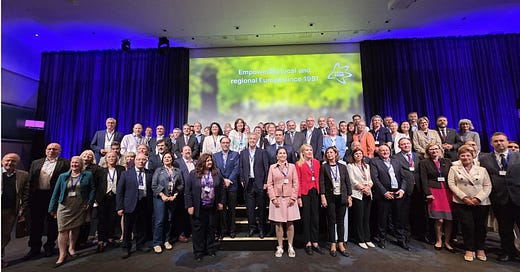Estepona's Mayor Defends His Sustainable Desalination Model in Europe
José María García Urbano presents the photovoltaic desalination plant project at the Oslo Leaders Summit
Estepona's Mayor, José María García Urbano, defended the sustainable seawater desalination model powered by photovoltaic energy at the Council of European Municipalities and Regions (CEMR) Leaders Summit in Oslo. The project, which will produce 15 million liters daily, is in the land acquisition phase for construction.
Estepona's Mayor, José María García Urbano, presented his innovative seawater desalination model powered by photovoltaic energy in Oslo, as a representative of the Spanish Federation of Municipalities and Provinces (FEMP), at the Council of European Municipalities and Regions (CEMR) Leaders Summit. This model, aimed at ensuring the town's water self-sufficiency, addresses drought through an ecological and sustainable desalination process.
A sustainable solution to water scarcity
The Estepona desalination project, which is in the process of acquiring land for its construction, will generate up to 15 million liters of water daily, enough to supply the local population. García Urbano explained that this modular plant can be adapted to the municipality's specific needs and serves as a viable solution to tackle drought crises autonomously.
Energy innovation to reduce costs
One of the project's key aspects is its low energy footprint, thanks to its operation with photovoltaic panels. In a region like the Costa del Sol, which enjoys around 330 days of sunshine annually, this model will generate sufficient electricity to power the desalination plant, significantly reducing energy costs, which have historically been a major challenge for seawater desalination.
The mayor emphasized that desalination previously carried high energy costs, which inflated the final water price. However, with the introduction of photovoltaic solar energy, Estepona will not only reduce costs but also promote environmental sustainability.
Advanced technology to mitigate environmental impact
García Urbano highlighted the use of advanced technologies to minimize the traditional issues caused by the brine produced during desalination. In the past, brine was discharged near the coast, causing significant damage to marine wildlife. The new model, however, incorporates a system that allows for industrial use of the brine, pumping it 2-3 kilometers out to sea, thus avoiding its negative effects on the local ecosystem.
Estepona is positioning itself as a leader in sustainable water management on the Costa del Sol. The mayor emphasized that this desalination model will be crucial for ensuring a reliable and cost-effective water supply for both residents and the tourism sector in the face of climate change and water scarcity.
Sign up for the next Networking event by Mejorllamaajavier at Savage Coworking Estepona next Friday, June 27th at 7:00 PM at Savage Coworking.
The modular desalination project is moving forward with land acquisition, and with an investment of nearly 20 million euros, Estepona is expected to have a sustainable and autonomous water supply in the near future. The combination of photovoltaic energy and seawater desalination promises to be a long-term solution in the fight against drought on the Costa del Sol.





